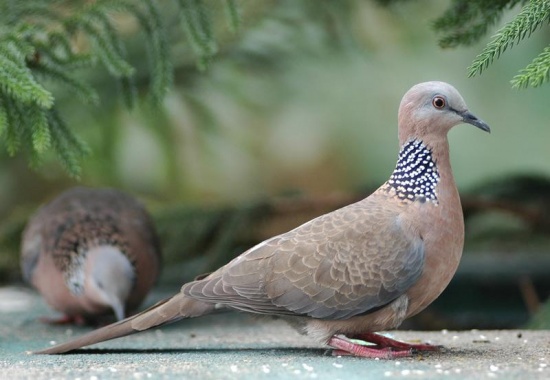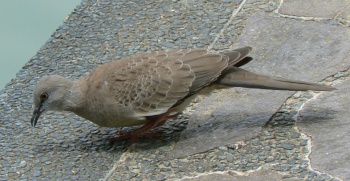Alternative name: Eastern Spotted Dove
- Spilopelia chinensis
Streptopelia chinensis
Identification
Length 27·5–30 cm (10¾-11¾ in), weight 120-130 g
- Pale brown back, wings and tail, heavily spotted with buff
- Blackish flight feathers bordered on the inner edge with pale grey
- Pink head and underparts
- Pale grey face and lower belly
- Black neck patch finely spotted with white
- Red legs
Sexes are similar
Juveniles are duller than adults often lacking the patchy neckband when very immature.
Distribution
Southern Asia from Nepal, India and Sri Lanka east to south China and Southeast Asia.
It has been introduced to Australia and New Zealand, Mexico, several Pacific Ocean islands, and parts of the United States (abundant in Hawaii, local in California).
Taxonomy
This species has recently been transferred, with its closest relative the Laughing Dove, to the genus Spilopelia by several authorities following the studies of Johnson et al. (2001) [3].
Subspecies
Clements recognizes these subspecies[1]:
- Northern India to Malaya, Indochina, Philippines, Greater and Lesser Sundas
- S. c. suratensis:
- S. c. ceylonensis:
- [[Sri Lanka}}
Some authorities suggest that S. c. suratensis may be better treated as a distinct species [4]; it differs in much more strongly marked wing coverts.
Habitat
Open woodland, farmland and habitation.
Behaviour
They are fairly terrestrial, foraging on the ground in grasslands and cultivation.

Photo: Alok Tewari
Hill Station Kasauli, Alt. 1927 metres, Himachal Pradesh, India, June-2013
Breeding
They breed throughout the year. Their round with stick nests are found in trees, edge of buildings or on the ground. The clutch consists of 2 glossy white eggs.
Diet
The diet is not too well recorded but is known to include grass and herb seeds, grains and small fruit.
Vocalisation
Call: a repeated sequence of coos
Recording by Alok Tewari
Rishikesh, Uttarakhand Himalayas, India, August-2017
One individual giving two types of calls. Recorded in late afternoon. Occasional calls by Purple Sunbird and Common Myna.
References
- Clements, J. F., P. C. Rasmussen, T. S. Schulenberg, M. J. Iliff, T. A. Fredericks, J. A. Gerbracht, D. Lepage, A. Spencer, S. M. Billerman, B. L. Sullivan, and C. L. Wood. 2023. The eBird/Clements checklist of Birds of the World: v2023. Downloaded from https://www.birds.cornell.edu/clementschecklist/download/
- Gill, F, D Donsker, and P Rasmussen (Eds). 2023. IOC World Bird List (v 13.2). Doi 10.14344/IOC.ML.13.2. http://www.worldbirdnames.org/
- Johnson, K. P. et al. (2001). A molecular phylogeny of the dove genera Streptopelia and Columba. The Auk 118 (4): 874–887.
- Handbook of the Birds of the World Alive (retrieved May 2015)
- Del Hoyo, J, A Elliot, and J Sargatal, eds. 1997. Handbook of the Birds of the World. Volume 4: Sandgrouse to Cuckoos. Barcelona: Lynx Edicions. ISBN 978-8487334221
Recommended Citation
- BirdForum Opus contributors. (2024) Spotted Dove. In: BirdForum, the forum for wild birds and birding. Retrieved 19 April 2024 from https://www.birdforum.net/opus/Spotted_Dove
External Links
GSearch checked for 2020 platform.1






